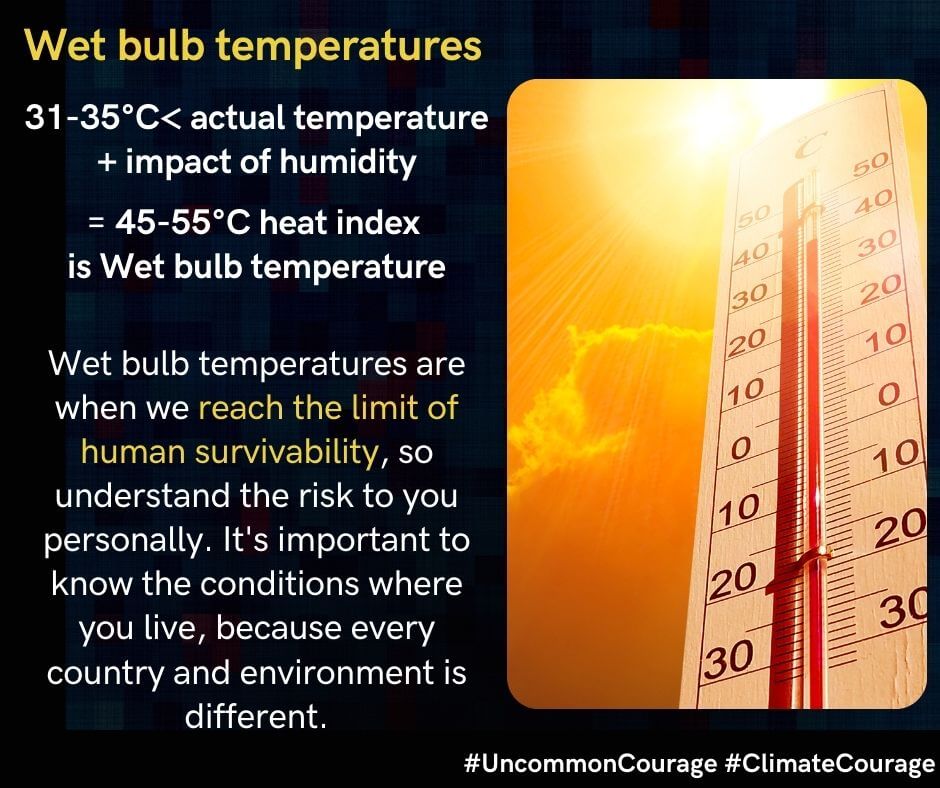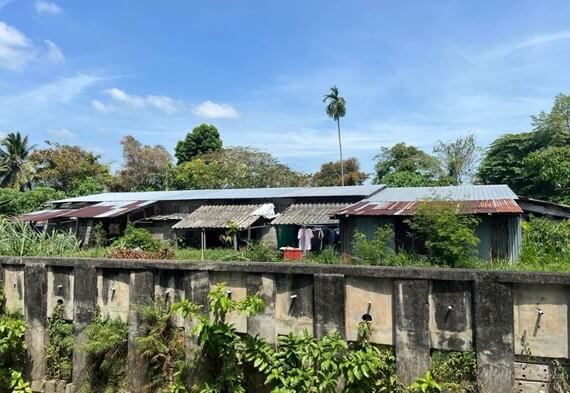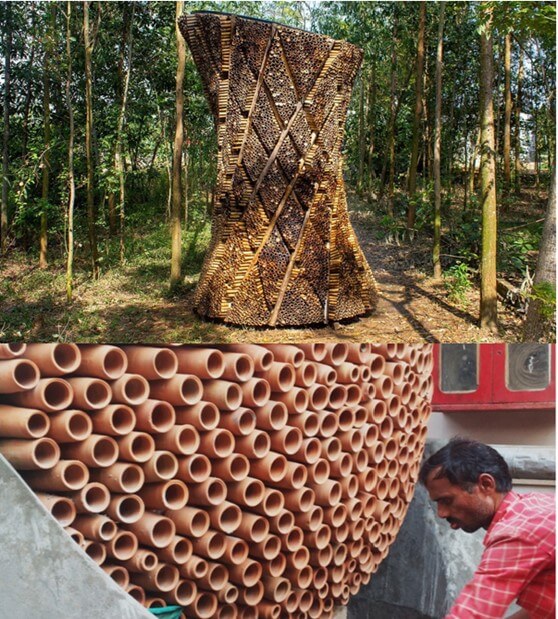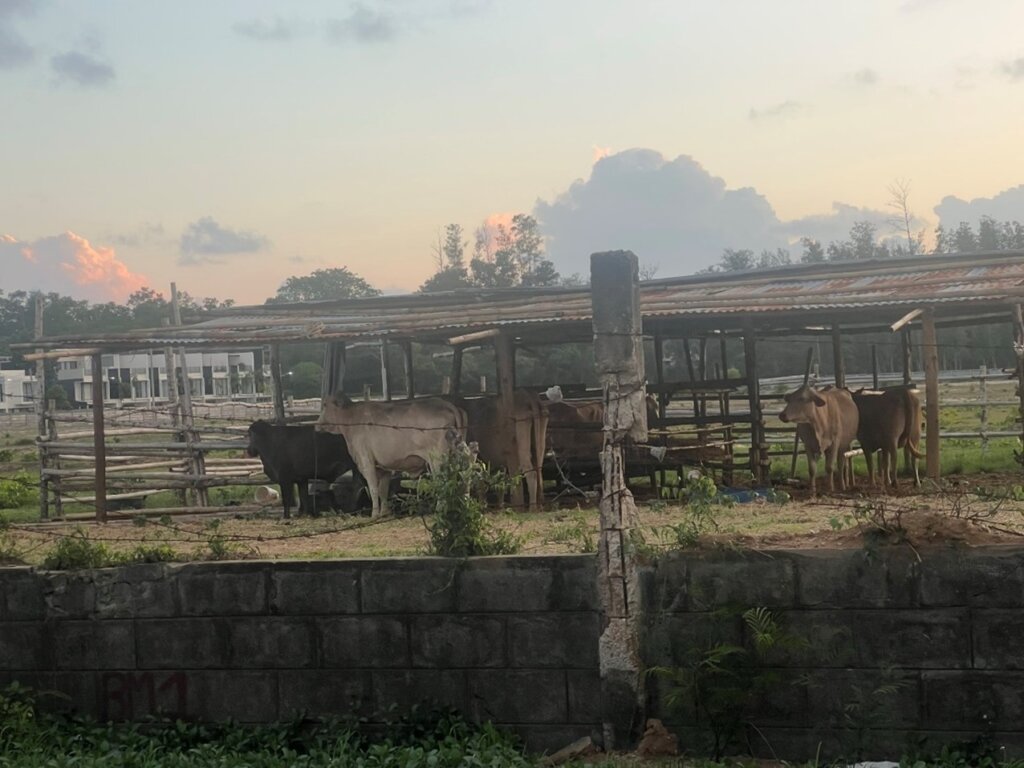This is the short version of this article, just focusing on actions. If you want to find the longer, more detailed version, backed up with extensive research, you can find it here.
What can we do to prepare for un-liveable heat?
With extreme heat, the most important job is to understand what wet bulb temperatures are and when it puts us at risk.
Here is a scientific explanation of wet bulb temperatures, a Guardian article, and Wikipedia’s version.
Watch: Too HOT and HUMID to Live: Extreme Wet Bulb Events Are on the Rise
The key part of understanding wet bulb temperatures is it’s a measurement of how much humidity is in the air combined with actual temperatures.
Check out the Wet Bulb Temperature Calculator.
And here is a short video from World Economic Forum discussing wet bulb temperatures.
Most important, we all need to understand what dangerous temperatures look like where we live. Equally, from now on, every year, these wet bulb temperatures will impact us more, it will get hotter and last longer. That is why it’s critical we start adaptation plans now and get prepared.
If you look at your weather apps, you will see weather reported as actual temperature, as well as with a heat index, which is what the temperature ‘feels like’ or the ‘real feel’ when combined with humidity. This is where you look at wet bulb temps.

Understanding the impacts of heat stroke
According to Business Insider, there are three stages, which I’ve summarized below:
- Stage one is dehydration. As you start to overheat, you lose fluids and electrolytes and might start feeling unwell. Signs are feeling weak, tired, and thirsty, as well as sweating and cramping. Action required, get out of the heat, drink water and electrolytes (stock up on electrolyte powders next time you’re out shopping)!
- Stage two is heat exhaustion. The symptoms are overheating (heat exhaustion) include headache, fever, dizziness, fainting, shallow breathing, increased thirst, muscle aches, and nausea. You can also appear pale and clammy, and your heart rate could be elevated because your body is working hard to cool down. Action: If you are high-risk, medical intervention might be necessary, otherwise get to a cool place quickly.
- Stage three is heat stroke. This is when your body loses its ability to cool itself. At this point, our core body temperature can keep rising to dangerous levels, but our body has no “internal mechanism” to stop it. Symptoms of this stage include confusion, lack of sweat, reddened, dry skin, and organ failure. Action: This stage requires immediate medical attention as minutes start to matter.
Yikes, what can we do?
How do we cool down? How can we protect the poorest and most vulnerable among us? Will we be able to survive? What about animals, especially wildlife?
Take it seriously
The first job is to take heat seriously. The highest temperatures of the day are usually between 11am-3pm, but if the temperatures move into the record books, be more cautious than usual. It’s also important to wear natural light fibres, don’t get sunburnt, stay in the shade whenever you can, drink lots of water and electrolytes, avoid anything that dehydrates you (alcohol, coffee) and pay attention to how you’re feeling.
Don’t forget to check in on your family and community, especially anyone living alone, the elderly, those with pre-existing medical conditions, and pregnant women.
If temperatures move into the wet bulb range, find the coolest place you can and if you have not already done so, now is a good time to download an effective weather app on your phone, and when it gets hot, pay attention to the heat index or ‘real feel.’
If you live in a town or community, create a screen or noticeboard with this information so everyone is aware. This is very important for millions of people without access to phones or technology – a big issue in the Global South.
Heat-Related Illness – What to do if someone is suffering from heat stroke?
Practical tips and ideas
Some of these do not cost much, while others are more expensive and extensive, requiring government and business funding. We must work together to invest time and effort as communities, especially in the poorer areas across the developing world, which could have a very significant positive impact.
In the Global South we need to focus on workers’ camps, refugee camps, slums, and homes with tin roofs or inadequate housing, which will be deadly in wet bulb temperatures because these homes will absorb the heat. It will be impossible to survive extreme heat in poor housing, especially with so few having air-conditioners, and if we do not prepare, we should be ready for mass deaths as wet bulb temperatures become the norm.

Paint it white
A simple action is to paint our roofs white. Check out the world’s whitest paint which reflects 98.1% of light and could help in the climate fight, a paint so powerful, it could eliminate the need for air-conditioning. We need to buy the most reflective white paint possible and get to work, painting roofs everywhere.
For worker camps, refugee camps, indigenous villages, etc… governments or businesses responsible must get them prepared, and look at shading and trees too.
Make it green
We can also grow plants on our roofs, although in the tropics, it could attract snakes, rats and more – which is why white roofs might be a better option. According to the World Economic Forum, urban greening is a big opportunity and includes things like living walls, roofs and green corridors. This is an important focus because when water vapour is released by plants during photosynthesis, it helps to cool the environment.
If you have wealth and trees where you live (anywhere in the world), please invest in planting trees in poorer neighbourhoods because these neighbourhoods often have few or no trees. The difference in temperatures between those with mature trees and those without is significant at 10°C.
Close curtains, install film on windows, insulation
If you have large windows, when the heat index starts moving past 50°C, keep your curtains closed and if you haven’t got curtains, it might be time to invest in the highest quality you can afford. You can also place sun-resistant film on your windows to reduce the heat impact in your home.
Make sure you have appropriate insultation to keep it cool inside and to stop the heat from getting in. It also ensures the air-conditioning is more efficient, or if you paint your roof white, it helps it do the job better.
Stock up on water
If your power grid goes down, do you lose to water? Time to stockpile enough water for your family for at least a week, if not longer. Also prepare sealed containers of water that can be used to cool down the body. If we can’t run our taps, having water supplies ready could be a lifesaver. One of the best ways to cool down is to soak towels in water and cover yourself with a wet towel. Make sure you have water supplies to be able to do this.
Tools requiring no power
Whether it’s handheld fans, lights, or any device that can help you stay cool, this is a great time to think about what you need when the power goes out and what could help you survive. To start with, we may only experience a few days of this heat, but as the earth warms, we will experience longer and more devastating heatwaves. What can get you through? Battery-powered fans? Hand crank generators for charging phones, and other necessary devices? This is a good time to reflect on what is necessary so that you can get prepared.
Be mosquito smart
A threat of the looming El Niño is an increase in infectious diseases from mosquitos, specifically dengue and malaria. While we must keep our home environments clear of pools of water, where mosquito larvae are commonly found, we may not be able to control the larger environment. Therefore, is it time to invest in mosquito nets and other solutions? As this is a bigger societal issue, we need to ask what more our governments can do to protect its citizens from infectious diseases. Bring it up with your leaders and vote for action.
Plant a garden
One impact of higher temperatures is crop loss, which is a growing concern around the world due to all forms of extreme weather. As an example, rice production is down in major markets across the world, and when temperatures pass 35C (which has already happened in 2023), rice crops start to fail, which means less produce making it to market – pushing up prices, and potentially leading to famine.
If you have not already started, please plant a garden, and encourage your neighbours to do the same. It could save your life and with so much unpredictability, especially in our food supply chain – which is getting worse and will continue to get worse – any way we can be independent in the coming years will help us and our families survive.
Cool it down outdoors
We need cooling options that do not rely on electricity, because cooling without power is much better for the environment, especially as many of the countries in the Global South are powered by coal – the dirtiest fossil fuel.
But it’s also about investing in solutions that work without power. One of the biggest challenges of extreme heat is, once temperatures pass 50°C, power grids start to fail due to the extreme temperatures and too much demand.
Two examples of outdoor cooling solutions that do not run on energy are the Yankodesign Adiabatic Urban Cooling bamboo tower and CoolAnt’s Beehive, which is made of terracotta. These solutions run on air and water.
We need solutions like this in worker camps, Indigenous villages, refugee camps, slums, markets, at festivals, religious events, and so on, as well as the main areas where citizens and tourists gather.

Solar powered water mist fans
Industrial-scale water mist fans could be vital in cooling the skin in wet bulb temperatures. However, to ensure success, we would need to look at running these fans off independent solar panels to ensure they don’t go down when the grid goes down.
Communal cooling stations
We need to establish cooling stations everywhere. For cities, existing infrastructure – like shopping malls, schools, or places of worship – are options when the temperature is too hot to live. This plan needs to be thought through, from setting up the space to providing water, food, and even places to sleep.
Outside of towns and cities, cooling stations need to be established in local villages and communities. Identify one or two places, large enough for everyone as the local cooling station, and put extensive forethought into planning these spaces to ensure they are ready to receive the community when the temperatures require it – which in many parts of the world is now. This can be a community-led action.
Cooling stations need to be accessible within a short timeframe.
Don’t forget our animal friends
If we want to be humane and smart about our future, we can’t forget animals and wildlife. From our pets to farm animals, can we keep them safe, ensuring they survive these temperatures?

How do we protect wildlife?
What can we do for wildlife? Can we set up spaces for birds and other wildlife, with access to water, food and shade? Should we be thinking about mini-ark-like structures to protect wildlife in our countries/regions to give them a fighting chance?
We must take care of our wildlife, or biodiversity loss and extinction will follow, and we can never forget the survival of these ecosystems is critical for human survival too. Can we plan to save enough mammals, amphibians, insects, plants, etc… so we have a chance of stopping anything else going extinct on our watch?
Independent energy investments
When the temperature gets too hot, high demand, as well as excessive heat, will see power grids fail. It’s already happening. To address this, if you have wealth, set up solar or wind energy for your property so you can be independent of the grid, but also because we need to reduce demand on the grid wherever possible too.
For communities, where it is not affordable for individuals to make the investment in solar or wind energy, come together and agree where you should set up independent energy sources and aircon units, ensuring there is enough to support everyone in the community. This will provide the whole community with a place to cool down, and it could save lives.
If communities can fund this together, there is a greater chance of having it ready to go when higher temperatures hit. This is not an area to delay. Those temperatures have already arrived across much of the Global South in 2023. If you have wealth, help your community make this investment.
What temperature does infrastructure start to fail?
- Every country is different, but on average, from approx. 50°C electricity grids can start to fail from too much demand OR because it’s too hot. This is extremely dangerous for anyone trying to survive in wet bulb temperatures.
- Roads can start disintegrating from approx. 50°C, telecoms are at risk too.
- Generators start being less efficient from 40°C and are less effective in high humidity environments.
- Solar panels can keep working until 65°C.
Important we know infrastructure thresholds where we live.
Sports, festivals, play, schools
It is important to be aware when your country is experiencing wet bulb temperatures and if so, do not go outside for any extended time. Pay attention to government advice when they say do not go outdoors and do not do any strenuous exercise in this heat.
For political rallies, religious ceremonies, or even large-scale sporting events, if the wet bulb temperature has been exceeded, it is in the interest of the organizers to either cancel these events or, where possible, move them indoors to an air-conditioned venue.
Schools must be aware of wet bulb temperatures and make sure students are not out in this heat for extended periods of time. Classrooms in the affected regions must prioritize installing air conditioning, if possible, as well as independent energy sources (like solar) to keep the students safe.
Painting roofs white, green roofs, outdoor cooling devices, trees and shade, etc… are all important focus areas for civic and institutional buildings.
Please pay attention to extreme heat if you are organizing any outdoor activity, because ignoring wet bulb temperatures puts lives at risk. If you want to survive, learn what you need to do and make sure you share this with your family and the wider community.
Embrace traditional cooling architecture
For all accommodation, we need to rethink how we build for the future we have coming, and this includes preparing mass accommodation options (e.g: for climate refugees) – which should be a priority if we plan to approach this humanely. We also need to embrace techniques of the past and repair what we have broken.
An example in the Asia region and a feature of the West Coast of Southeast Asia is Peranakan architecture, which was designed to cool and keep air circulating before electricity and air-conditioning was invented! The challenge is, when you visit these areas today, many of their features have been altered, such as the arches between buildings and shops are now blocked and covered over. This means less air circulation. We need to reverse this, and it’s a relatively simple job.
We also need to look at installing shade in public areas everywhere. Trees and plants are critical too.
Everything, everywhere all at once
While we urgently need to get prepared for extreme heat, at the same time, we must address the destruction of the natural world, and that requires investing our energy and investments into turning around the destruction we have caused, which is making the climate emergency worse and the reason we are dealing with this extreme weather.
The head of the United Nations, Antonio Guterres, recently said: we need everything, everywhere all at once, so it is time for our communities to come together everywhere and work out how to replenish and rewild the land we call home. Clean it up, bring it back to life, stop the human sprawl, limit developments not in alignment with nature, etc… all while preparing for hotter and hotter temperatures at the same time.
We must address the reasons for the hotter temperatures, however, even if we do all we can, we must accept it will continue to get hotter and last longer. More so if the rest of the world continues with business as usual.
A few points
- It is critical we act everywhere, and it’s time to get to work to see if we can partner with nature to lessen the impact of the escalating climate emergency. In parallel, to deal with wet bulb temperatures, let’s rewild our environments as quickly as possible.
- If we’re on the ocean, we need to work out the best techniques that will contribute to emission reductions and other benefits, such as seagrass meadows, mangroves, oysters, repopulating important species and so on.
- On the land, it’s trees, plants, animals and more. Let’s ask our village elders or local Indigenous communities for guidance on returning our communities to nature everywhere, and we should look back at least 50 years for inspiration.
- Let’s clean up the waste and work out how to ensure a clean environment (banning ALL single-use plastics, setting up effective waste collection, composting, etc…). Plastic waste also blocks drains and increases flood risk, so there’s a huge benefit to cleaning up our environments.
- Across the Global South, the waterways and lands are covered in trash, and this waste is not just domestic, as Western countries have been shipping waste to this region for decades. That practice must stop, it’s waste colonialism.
- The never-ending build-up of all waste, as well as over-development, poor planning, etc… mean water supplies across the world, but especially in the Global South, are polluted and undrinkable. More alarming, in a world rapidly heading towards water shortages, prioritizing cleaning and reinvigorating the waterways must be a priority for all countries.
Rethinking outdoor work
The vast majority of people that will be impacted by intense wet bulb temperatures are outdoor workers, and these are typically the people responsible for feeding, building and entertaining the world. We need to rethink hours of work to ensure they escape the heat, as well as plan for cooler places they can go when temperatures are too high. It’s critical the owners of businesses are made responsible for ensuring the safety of workers – which is not something that happens everywhere, especially when the workers are foreign or undocumented migrants.
The sort of outdoor work to consider:
- Agriculture, farming
- All construction
- Transportation, especially if motorbikes are the primary vehicle (Grab drivers) and tourism vehicles, like Tuk-Tuks
- Outdoor markets – from fruit and vegetables, seafood, to clothes to tourism
- Gardeners and outdoor domestic workers
- Hospitality employees with primary roles outdoors, including restaurant staff
- Tourism sector, such as golf caddies, diving instructors, water sports, touts and more
- Emergency service workers
Infrastructure meltdown
Our infrastructure is not ready for extreme heat, and a huge challenge in the Global South is most of the electrical infrastructure is still above ground because it is significantly cheaper than installing it under ground. This means it is at higher risk of shutting down due to the heat or getting damaged (by storms, etc..), so another important measure will be investing in the infrastructure to ensure it is suitable for higher temperatures and other weather extremes.
We also need to think through what this means. As an example, when roads start to melt, we will not be able to leave our homes. If we can’t leave our homes, what does that mean – especially if considering food, water supplies, medical emergencies, and so on?
We must also consider the ability of emergency services personnel to get infrastructure working in the intense heat. At the peak of temperatures, will the emergency vehicles be able to drive – as overheating vehicles and melted roads could be an issue? And if they can get to the areas, what clothing will they require – such as cooling suits? We need to prepare for this now.
Car and motorbike parking shelter
The intense heat in 2023 has left cars and motorbikes cooking in the sun, and for those without air-conditioning in cars, not being able to park in shaded areas will become a major issue. You cannot cool a car down when it has been exposed to this level of heat; therefore, it is time to install parking shelters everywhere, which is not a general practice in the developing world.
It is also a great opportunity to learn and take inspiration from countries like France, which is installing solar panels on the roofs of all large carparks. For hospitals across the region, installing solar panels on car and motorbike shelters could provide energy for the hospital and the surrounding community.
Securing health services
What is more important than healthcare services? How do we ensure it continues to run? First up is establishing independent and sustainable energy supplies that are powerful enough to run whole facilities, such as hospitals and all emergency services providers.
Most energy sources currently in use are electrical grids that are at risk of breaking down, followed by generators running on fossil fuels. The question is – when does it get too hot to run a generator? According to this article it’s 40°C and humidity is a risk too.
If heat and humidity exceed the ability of the generators to run or be reliable, we need to understand what that is now and act quickly to replace it with more appropriate options for the future we have coming. We also need to ensure there is enough medication, food and water to get through any extended heatwave.
Hospital leaders and government officials – national and local – need to ask the question: “Will the current infrastructure work in the heat predicted by climate scientists?”
Localized medical facilities
Another consideration is the number of people needing medical care has the potential to explode. Equally, if people can’t travel to medical centres (car too hot to start, un-drivable roads) or they are too far away (minutes are precious when you move into stage three heat stroke), we need to plan how we deal with that, now.
So, let’s get ready and set up local services. What equipment is required for emergencies, and how can we train local community members to deliver emergency medical care in situations where getting to hospitals or clinics isn’t possible.
If we want to get prepared, we need to
- Identify the number of communities in each country
- Nominate a person/people to be trained by medical professionals in heat stroke care and educate the community that this is where anyone suffering heat stroke should come
- Determine what equipment, medication is needed in each facility and start getting stockpiles in place and secured
- Install independent energy sources so these local facilities can be successful, no matter how hot it gets
- Set these facilities up now, in advance of when it’s needed
- Prepare “survival packs” with items like electrolytes, and distribute to citizens before the heat arrives
It’s also a good time to invest in medical teams producing ‘how to’ videos in local language, about how to handle a wet bulb temperature emergency, and the signs to look out for.
How To Treat Heat Stroke, Signs & Symptoms – First Aid Training – St John Ambulance
The media
The media needs to report on wet bulb temperatures and educate readers/viewers about what it means. It needs relentless attention to increase awareness of risks, as well as guidance on what will happen as we move into this next El Niño, which is expected to see temperatures we have never seen before.
The media must provide up-to-date, current information, predictions, and education on how to handle extreme heat, and it must prioritize this message. It is time to put wet bulb temperatures, with danger categories, on the front page of every media source.
Take inspiration from the French A Path-breaking Innovation in Climate Journalism
Influencers
Use your profile for good and take on the role of educating your audiences and contributing to this conversation.
Government leadership
Governments must call their citizens together, speak honestly and openly about what is happening, with words guided by science. We need all government leaders to set in place plans that are aligned with what climate scientists are communicating, and we need to start adapting now. All over the world, extreme climate events are putting leaders on the back foot, reacting after a disaster has already struck, and we need to start being ready in advance of what is coming.
Transparency is critical, openness and engagement with citizens too, and corruption is another area that must be addressed and tackled.
Governments must also work across borders for the good of the region and share best practices, help solve challenges that contribute to the crisis (like the haze), and rapidly reduce fossil fuels, especially coal, or it will keep getting worse.
Communication is critical
Governments need to put in place national communication plans, set up the system for this communication to ensure it reaches everyone under their care, put in place a team to manage this and get prepared, before the next emergency strikes. National and local communication will be vital.
Business
Executive leadership teams must start to look at all possibilities and understand the impact on their businesses and not just their bottom line. Some examples:
- If you are a large global corporation, you might have thousands of employees impacted by this heat – how can you help them? How can you get them prepared? Can you help install solar or wind, so their families are safe during intense heat events?
- Is your supply chain safe, or will it buckle in the heat, as we saw in China in 2022? What is the impact of that? How can you prepare your business?
- If tourism is your business and heat waves are killing people, this is not going to attract tourists to your destination. How are you preparing for this heat, and what are you doing for your employees? How are you planning to communicate with your guests?
- More broadly, for outdoor sectors, such as agriculture, transportation and tourism, your businesses will be severely impacted by this situation on multiple levels – crop loss, drought, and temperatures too hot for your employees to work in. What can you do now to prepare? What infrastructure can you put in place? How can you change working hours to stay productive and keep your employees safe?
- For any business relying on migrant labour or undocumented labour, this is a time for humanity. Take care of your people. Get their home camps in order so they have a chance of surviving. Don’t make them work and live in wet bulb temperatures, or they will die. Secure their food and water supplies, install cooling stations and change the hours of work.
Heat stroke
We need global cooperation
The wealthy countries around the world, who are responsible for the challenges the Global South are facing, MUST help these countries succeed. Without this help, the world will only get hotter, as coal use will escalate as countries deal with temperatures never seen in human history. Climate refugees will also be on the move because when it’s too hot to live and the water runs dry, what other choice do people have?
We must focus all our efforts on keeping people where they are, which will give us a much better chance of being able to get through these challenging years. We have all the evidence that the world is not kind and supportive of refugees, so let’s do what we need to do right now to stop people having to be on the move. Everyone wins when we focus on this.
Support of the Global South is vital for the people impacted, for global stability, and for world peace.
A time for compassion
In the months and years ahead, treating every living being with compassion and dignity needs to be at the core of how we think and plan. There are many communities – migrant workers, the undocumented and refugees – who are not provided with fundamental human rights.
We must address this, otherwise we will be shocked to learn that thousands, maybe even millions, will succumb to these temperatures in the not-to-distant future. The world is heating rapidly, we must get ready now.
Every person living in the Global South contributed minimally to the challenge the world faces as the climate emergency escalates, but all deserve the maximum amount of support to help them live through these challenging wet bulb temperatures.
Conclusion
I wrote this because I am very alarmed at the lack of adaptation taking place all over the globe. We must start getting prepared urgently. I hope it helps you and your community get ready, in every way you can, for the extreme heat we will be experiencing for longer and longer periods.
Unfortunately, regardless of what we do, we may never get this under control, but we can at least get prepared to live with these extreme temperatures, hoping the world comes to its senses and starts taking the drastic action necessary to reduce emissions, which are causing the heating and other extreme weather events.
Remember, the path out of despair and hopelessness is action. Let’s all get into action because that’s what the world needs to see now – ACTION! Lots and lots of action.
Cheers,
Andrea
Want to get in touch?
All of my contact information is here on Linktree.
Environment education
Four environment resources to help you navigate this challenging territory.
- Knowledge, constantly updating
- Individual action and awareness, so we do our part
- Resources for those struggling with eco-anxiety. Please share with your community.
- Finally, more than 100 mini-videos on many topics regarding the multiple crisis’ we face. Feel free to download and use as your own. No credit necessary.
Uncommon Courage: an invitation
Uncommon Courage is an invitation to be your courageous best self every day. It’s also an antidote to the overwhelm, fear, and rage rolling around the world. But it’s more than a book; it’s an invitation to join an inclusive community that wants to better understand humanities challenges – both global and personal – in order to take courageous action and create a better world for everyone. If Covid19 has given us the time and space to reflect, Uncommon Courage gives us the nudge we need to create lasting change.
You can buy it on Amazon, Apple Books, Barnes & Noble, Book Depository, Booktopia, Smashwords, Kobo, Gardners, Odilo, Indie Bound, BookShop by BookTrib and Scribd.
Better yet, order it from your local bookstore, so you can #SupportLocal.
You can read the reviews, including a new five-star review on Book Commentary, another five-star review on ReaderViews, a review on BookTrib, and three more on Booklife, another on Book Commentary and Blue Ink Reviews. I’m also collating reviews on my Website too. Have a look and grateful to everyone who has written or recorded one.
Come and join the conversation in my Facebook Group Uncommon Courage.
Listen in to the Uncommon Courage, the podcast on Apple, Spotify and everywhere podcasts are published.
The Know Show
Check out The Know Show. It’s a fortnightly wrap up of the news!
Climate Courage
A fortnightly conversation on issues that matter to you and I, focusing on the actions we can all take.
18 Steps to an All-Star LinkedIn Profile
Listed by Book Authority in the 100 Best LinkedIn Books of All Time and 22 Best New LinkedIn eBooks To Read In 2021 and 2022 categories. Grab it today if you want to take your professional presence to the next level! When it comes to LinkedIn, it really is time to ask — can you really afford not to have this book in the hands of every employee?
Are you a Social CEO? The Social CEO: How Social Media Can Make You A Stronger Leader.
Want to claim your stage? Unleash Your Voice – Powerful Public Speaking for Every Woman
Feedback
Have I done a great job for you? Can you write a reference on my LinkedIn profile or on my Google Business page? If not for me, why not write one for someone else who inspires you or has helped you? Join the #GivingEconomy.




Pingback: #147 Weekend reads – good on you Prince Harry - The Digital Conversationalist
Pingback: What can I do to act on climate & social change? First job is knowledge (2023 edition) - The Digital Conversationalist
Pingback: Can you give me advice on HOW to talk about the multiple planetary crises’? - The Digital Conversationalist
Pingback: 34 actions to prepare for a heat index that hits unliveable territory - The Digital Conversationalist
Pingback: वह क्षेत्र जो रहने लायक नहीं रहे, उन पर पड़ने वाले ताप सूचकांक की तैयारी के लिए 34 कार्रवाइयां: - The Digital
Pingback: 34 ขั้นตอนในการเตรียมตัวเพื่อสภาวะอุณหภูมิสูงถึงระดับที่ไม่สามารถอยู่ได้ - The Digital Conversationalist